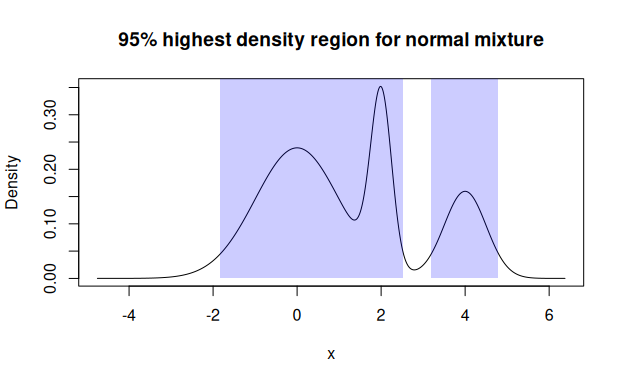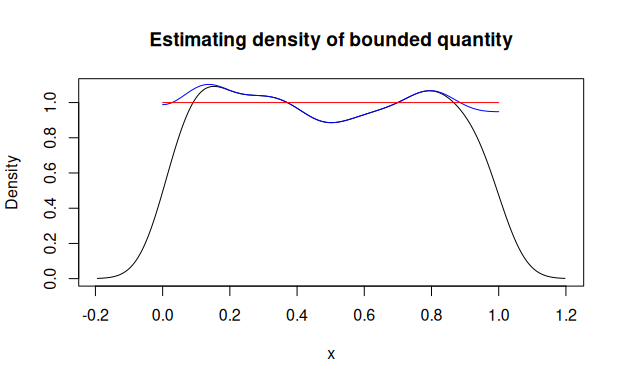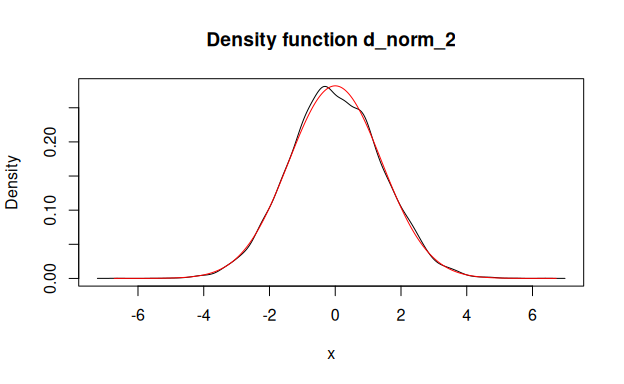Create, transform, and summarize custom random variables with
distribution functions (analogues of p*(),
d*(), q*(), and r*() functions
from base R), all of which called “pdqr-functions”. General idea is to
work with manually created distributions which can be described in four
interchangeable functional ways.
Typical usage is to:
new_*() family), and/or convert from some other existing
distribution function (with as_*() family).form_*()
family.summ_*() family.Two types of pdqr-functions, representing different types of distributions, are supported:
Implemented approaches often emphasize approximate and numerical solutions:
Note that to fully use this package, one needs to be familiar with basics of probability theory (concepts such as probability, distribution, density, etc.).
This README covers the following topics:
new_*().as_*().form_*().summ_*().‘pdqr’ is not yet on CRAN. You can install the development version from GitHub with:
# install.packages("devtools")
devtools::install_github("echasnovski/pdqr")Generate a sample from a distribution defined by some reference sample:
# Treat input sample as coming from a continuous distribution
r_mpg <- new_r(mtcars$mpg, type = "continuous")
r_mpg(n = 10)
#> [1] 17.3792362 10.4822955 22.8221407 21.8118788 15.5166760 16.3005293 20.5809388 16.8043292
#> [9] 21.1901692 19.9680967Compute winsorized mean:
# Import 'magrittr' to use pipe operator `%>%`
library(magrittr)
# Take a sample
mtcars$mpg %>%
# Create pdqr-function of any class treating input as discrete
new_d(type = "discrete") %>%
# Winsorize tails
form_tails(level = 0.1, method = "winsor", direction = "both") %>%
# Compute mean of distribution
summ_mean()
#> [1] 20.19375Compute and visualize distribution of difference of sample means:
# Compute distribution of first sample mean treating input as continuous
mpg_vs0 <- mtcars$mpg[mtcars$vs == 0]
d_vs0 <- new_d(mpg_vs0, "continuous")
(d_vs0_mean <- form_estimate(
d_vs0, stat = mean, sample_size = length(mpg_vs0)
))
#> Density function of continuous type
#> Support: ~[12.14822, 20.63362] (511 intervals)
# Compute distribution of second sample mean treating input as continuous
mpg_vs1 <- mtcars$mpg[mtcars$vs == 1]
d_vs1 <- new_d(mpg_vs1, "continuous")
(d_vs1_mean <- form_estimate(
d_vs1, stat = mean, sample_size = length(mpg_vs1)
))
#> Density function of continuous type
#> Support: ~[18.42035, 31.00767] (511 intervals)
# Compute distribution of difference of sample means using random simulation
(mpg_diffmean <- d_vs0_mean - d_vs1_mean)
#> Density function of continuous type
#> Support: ~[-15.97734, 0.93274] (511 intervals)
# Visualize with base `plot()`
plot(mpg_diffmean, main = "Distribution of difference of sample means")
Compute and visualize 95% highest density region for mixture of normal distributions:
# Create a list of pdqr-functions
norm_list <- list(
as_d(dnorm), as_d(dnorm, mean = 2, sd = 0.25), as_d(dnorm, mean = 4, sd = 0.5)
)
# Form a mixture with custom weights
norm_mix <- form_mix(norm_list, weights = c(0.6, 0.2, 0.2))
# Compute 95% highest density region
(norm_hdr <- summ_hdr(norm_mix, level = 0.95))
#> left right
#> 1 -1.82442072 2.53095750
#> 2 3.19649819 4.79334429
# Visualize
plot(norm_mix, main = "95% highest density region for normal mixture")
region_draw(norm_hdr)
new_*()All new_*() functions create a pdqr-function of certain
class (“p”, “d”, “q”, or “r”) and type (“discrete” or “continuous”)
based on sample or data frame (with appropriate structure):
density()
function if input has at least 2 elements. For 1 element special
“dirac-like” pdqr-function is created: an approximation of single
number as triangular distribution with very narrow support (1e-8
order of magnitude).All information about distribution that pdqr-function represents is
stored in its “x_tbl” metadata: a data frame describing
distribution with format similar to data frame input of
new_*() functions. One can get it using
meta_x_tbl() function.
Pdqr class correspond to the following functions describing distribution:
new_p().new_d(). Generally speaking, it is a derivative of
distribution’s p-function.new_q(). Inverse of distribution’s p-function.new_r(). Generates a random sample from
distribution.For more details see vignette about creating pdqr-functions.
# Treat input as discrete
(p_mpg_dis <- new_p(mtcars$mpg, type = "discrete"))
#> Cumulative distribution function of discrete type
#> Support: [10.4, 33.9] (25 elements)
(d_mpg_dis <- new_d(mtcars$mpg, type = "discrete"))
#> Probability mass function of discrete type
#> Support: [10.4, 33.9] (25 elements)
(q_mpg_dis <- new_q(mtcars$mpg, type = "discrete"))
#> Quantile function of discrete type
#> Support: [10.4, 33.9] (25 elements)
(r_mpg_dis <- new_r(mtcars$mpg, type = "discrete"))
#> Random generation function of discrete type
#> Support: [10.4, 33.9] (25 elements)
## "x_tbl" metadata is the same for all `*_mpg_dis()` pdqr-functions
head(meta_x_tbl(p_mpg_dis), n = 3)
#> x prob cumprob
#> 1 10.4 0.06250 0.06250
#> 2 13.3 0.03125 0.09375
#> 3 14.3 0.03125 0.12500
# Treat input as continuous
(p_mpg_con <- new_p(mtcars$mpg, type = "continuous"))
#> Cumulative distribution function of continuous type
#> Support: ~[2.96996, 41.33004] (511 intervals)
(d_mpg_con <- new_d(mtcars$mpg, type = "continuous"))
#> Density function of continuous type
#> Support: ~[2.96996, 41.33004] (511 intervals)
(q_mpg_con <- new_q(mtcars$mpg, type = "continuous"))
#> Quantile function of continuous type
#> Support: ~[2.96996, 41.33004] (511 intervals)
(r_mpg_con <- new_r(mtcars$mpg, type = "continuous"))
#> Random generation function of continuous type
#> Support: ~[2.96996, 41.33004] (511 intervals)
## "x_tbl" metadata is the same for all `*_mpg_con()` pdqr-functions
head(meta_x_tbl(p_mpg_con), n = 3)
#> x y cumprob
#> 1 2.96996269 0.000114133557 0.00000000e+00
#> 2 3.04503133 0.000125168087 8.98202438e-06
#> 3 3.12009996 0.000136934574 1.88198694e-05
# Output of `new_*()` is actually a function
p_mpg_dis(15:20)
#> [1] 0.18750 0.31250 0.34375 0.40625 0.46875 0.56250
## Random generation. "discrete" type generates only values from input
r_mpg_dis(10)
#> [1] 10.4 33.9 26.0 19.2 24.4 18.7 17.8 18.7 15.5 21.4
r_mpg_con(10)
#> [1] 35.7089680 33.3634914 31.1541225 15.6482281 20.8554689 13.7275908 11.3686051 16.7155604
#> [9] 20.6710197 20.5132727
# Special case of dirac-like pdqr-function, which numerically approximates
# single number with distribution with narrow support
(r_dirac <- new_r(3.14, "continuous"))
#> Random generation function of continuous type
#> Support: ~[3.14, 3.14] (2 intervals)
meta_x_tbl(r_dirac)
#> x y cumprob
#> 1 3.13999999 0 0.0
#> 2 3.14000000 100000001 0.5
#> 3 3.14000001 0 1.0# Type "discrete"
dis_tbl <- data.frame(x = 1:4, prob = 4:1 / 10)
new_d(dis_tbl, type = "discrete")
#> Probability mass function of discrete type
#> Support: [1, 4] (4 elements)
new_r(dis_tbl, type = "discrete")(10)
#> [1] 4 1 3 1 2 4 3 2 4 1
# Type "continuous"
con_tbl <- data.frame(x = 1:4, y = c(0, 1, 1, 1))
new_d(con_tbl, type = "continuous")
#> Density function of continuous type
#> Support: [1, 4] (3 intervals)
new_r(con_tbl, type = "continuous")(10)
#> [1] 2.21323986 1.58190910 2.85635049 2.32440194 2.44538842 2.89743821 3.29852362 2.43084969
#> [9] 2.81580878 2.79585280as_*()Family of as_*() functions should be used to convert
existing distribution functions into desired class (“p”, “d”, “q”, or
“r”). Roughly, this is a new_*() family but with function
as an input.
There are two main use cases:
For more details see vignette about converting pdqr-functions.
Converting existing pdqr-function to desired type is done straightforwardly by changing function’s class without touching the underlying distribution (“x_tbl” metadata is the same):
d_dis <- new_d(1:4, "discrete")
meta_x_tbl(d_dis)
#> x prob cumprob
#> 1 1 0.25 0.25
#> 2 2 0.25 0.50
#> 3 3 0.25 0.75
#> 4 4 0.25 1.00
# This is equivalent to `new_p(1:4, "discrete")`
(p_dis <- as_p(d_dis))
#> Cumulative distribution function of discrete type
#> Support: [1, 4] (4 elements)
meta_x_tbl(p_dis)
#> x prob cumprob
#> 1 1 0.25 0.25
#> 2 2 0.25 0.50
#> 3 3 0.25 0.75
#> 4 4 0.25 1.00Another important use case for as_*() functions is to
convert some other distribution functions to be pdqr-functions. Except
small number of special cases, output of as_*() function
will have “continuous” type. The reason is because identifying exact
values of distribution in discrete case is very hard in this setup (when
almost nothing is known about the input function). It is assumed that if
user knows those values, some new_*() function with data
frame input can be used to create arbitrary discrete pdqr-function.
General conversion algorithm is as follows:
new_*() function is created which approximates input
function. Approximation precision can be tweaked with
n_grid (and n_sample for as_r())
argument.Note that output is usually an approximation of input due to the following facts:
# "Honored" distributions
as_d(dnorm)
#> Density function of continuous type
#> Support: ~[-4.75342, 4.75342] (10000 intervals)
## Different picewise-linear approximation precision
as_d(dnorm, n_grid = 101)
#> Density function of continuous type
#> Support: ~[-4.75342, 4.75342] (100 intervals)
## Different extra arguments for input
as_d(dnorm, mean = 10, sd = 0.1)
#> Density function of continuous type
#> Support: ~[9.52466, 10.47534] (10000 intervals)
# Custom functions
my_d <- function(x) {
ifelse(x >= -1 & x <= 1, 0.75 * (1 - x^2), 0)
}
## With algorithmic support detection
as_d(my_d)
#> Density function of continuous type
#> Support: ~[-1.00018, 1.00019] (7588 intervals)
## Providing custom, maybe only partially known, support
as_d(my_d, support = c(-1, NA))
#> Density function of continuous type
#> Support: ~[-1, 1.00007] (9327 intervals)
as_d(my_d, support = c(-1, 1))
#> Density function of continuous type
#> Support: [-1, 1] (10000 intervals)form_*() and base operationsConcept of form functions is to take one or more pdqr-function(s) and
return a transformed pdqr-function. Argument method is used
to choose function-specific algorithm of computation.
For more details see vignette about transforming pdqr-functions.
form_*() familyThere are several form_*() functions. Here are some
examples:
# Transform support of pdqr-function with `form_resupport()`. Usually useful
# for dealing with bounded values.
d_smpl <- new_d(runif(1000), type = "continuous")
d_smpl_bounded <- form_resupport(d_smpl, support = c(0, 1), method = "reflect")
plot(d_smpl, main = "Estimating density of bounded quantity", col = "black")
lines(d_smpl_bounded, col = "blue")
## Reference uniform distribution
lines(as_d(dunif), col = "red")
# Perform general transformation with `form_trans()`. This is usually done by
# randomly simulating sample from output distribution and then calling one of
# `new_*()` functions.
d_norm <- as_d(dnorm)
## More accurate result would give use of `+` directly with: d_norm + d_norm
d_norm_2 <- form_trans(list(d_norm, d_norm), trans = `+`)
plot(d_norm_2, col = "black")
lines(as_d(dnorm, sd = sqrt(2)), col = "red")
Almost all basic R operations (implemented with S3 group generic
functions) has methods for pdqr-functions. Operations are done as if
applied to independent random variables with distributions represented
by input pdqr-function(s). Many of methods have random nature and are
implemented with form_trans(), but have little tweaks that
make their direct usage better than form_trans().
d_norm <- as_d(dnorm)
d_unif <- as_d(dunif)
# Distribution of difference of random variables. Computed with random
# simulation.
d_norm - d_unif
#> Density function of continuous type
#> Support: ~[-5.02445, 3.65236] (511 intervals)
# Comparing random variables results into boolean random variable represented
# by boolean pdqr-function (type "discrete" with values 0 for FALSE and 1 for
# TRUE). Here it means that random value of `d_norm` will be greater than random
# value of `d_unif` with probability around 0.316. This is computed directly,
# without random simulation.
d_norm > d_unif
#> Probability mass function of discrete type
#> Support: [0, 1] (2 elements, probability of 1: ~0.31563)
# Distribution of maximum of three random variables. Computed with random
# simulation.
max(d_norm, d_norm, d_norm)
#> Density function of continuous type
#> Support: ~[-2.3575, 4.11583] (511 intervals)summ_*()Concept of summary functions is to take one or more pdqr-function(s)
and return a summary value. Argument method is used to
choose function-specific algorithm of computation.
For more details see vignette about summarizing pdqr-functions.
my_d <- as_d(dbeta, shape1 = 1, shape2 = 3)
# There are wrappers for all center summaries
summ_center(my_d, method = "mean")
#> [1] 0.249999259
summ_center(my_d, method = "median")
#> [1] 0.20629921
summ_center(my_d, method = "mode")
#> [1] 0
# There are wrappers for spread summaries
summ_spread(my_d, method = "sd")
#> [1] 0.193647842
# These return essentially the same result
summ_moment(my_d, order = 2, central = TRUE)
#> [1] 0.0374994867
summ_spread(my_d, method = "var")
#> [1] 0.0374994867Distributions can be summarized with regions: union of closed intervals. They are represented as data frame with rows representing intervals and two columns “left” and “right” with left and right interval edges respectively.
# 90% highest density region (HDR)
summ_hdr(my_d, level = 0.9)
#> left right
#> 1 0 0.535887
## In case of unimodal distribution HDR is essentially the same as 90% interval
## of minimum width
summ_interval(my_d, level = 0.9, method = "minwidth")
#> left right
#> 1 0 0.535839727
summ_interval(my_d, level = 0.9, method = "percentile")
#> left right
#> 1 0.0169524103 0.631594521Function summ_distance() takes two pdqr-functions and
returns a distance between two distributions they represent. Many
methods of computation are available. This might be useful for doing
comparative statistical inference.
my_d_2 <- as_d(dnorm, mean = 0.5)
# Kolmogorov-Smirnov distance
summ_distance(my_d, my_d_2, method = "KS")
#> [1] 0.397684098
# Total variation distance
summ_distance(my_d, my_d_2, method = "totvar")
#> [1] 0.706221267
# Probability of one distribution be bigger than the other, normalized to [0;1]
summ_distance(my_d, my_d_2, method = "compare")
#> [1] 0.194615851
# Wassertein distance: "average path density point should go while transforming
# from one into another"
summ_distance(my_d, my_d_2, method = "wass")
#> [1] 0.685534883
# Cramer distance: integral of squared difference of p-functions
summ_distance(my_d, my_d_2, method = "cramer")
#> [1] 0.165921075
# "Align" distance: path length for which one of distribution should be "moved"
# towards the other so that they become "aligned" (probability of one being
# greater than the other is 0.5)
summ_distance(my_d, my_d_2, method = "align")
#> [1] 0.251020429
# "Entropy" distance: `KL(f, g) + KL(g, f)`, where `KL()` is Kullback-Leibler
# divergence. Usually should be used for distributions with same support, but
# works even if they are different (with big numerical penalty).
summ_distance(my_d, my_d_2, method = "entropy")
#> [1] 12.6930974Function summ_separation() computes a threshold that
optimally separates distributions represented by pair of input
pdqr-functions. In other words, summ_separation() solves a
binary classification problem with one-dimensional linear classifier:
values not more than some threshold are classified as one class, and
more than threshold - as another. Order of input functions doesn’t
matter.
summ_separation(my_d, my_d_2, method = "KS")
#> [1] 0.637042714
summ_separation(my_d, my_d_2, method = "F1")
#> [1] -6.02372908e-05Functions summ_classmetric() and
summ_classmetric_df() compute metric of classification
setup, similar to one used in summ_separation(). Here
classifier threshold should be supplied and order of input matters.
Classification is assumed to be done as follows: any x value not more
than threshold value is classified as “negative”; if strictly greater -
“positive”. Classification metrics are computed based on two
pdqr-functions: f, which represents the distribution of
values which should be classified as “negative” (“true negative”), and
g - the same for “positive” (“true positive”).
# Many threshold values can be supplied
thres_vec <- seq(0, 1, by = 0.2)
summ_classmetric(f = my_d, g = my_d_2, threshold = thres_vec, method = "F1")
#> [1] 0.513819342 0.580222932 0.614898704 0.603832562 0.549732861 0.471575705
# In `summ_classmetric_df()` many methods can be supplied
summ_classmetric_df(
f = my_d, g = my_d_2, threshold = thres_vec, method = c("GM", "F1", "MCC")
)
#> threshold GM F1 MCC
#> 1 0.0 0.000000000 0.513819342 -0.427093061
#> 2 0.2 0.549127659 0.580222932 0.106817345
#> 3 0.4 0.650557843 0.614898704 0.333936376
#> 4 0.6 0.656293762 0.603832562 0.450433146
#> 5 0.8 0.615655766 0.549732861 0.472055694
#> 6 1.0 0.555461222 0.471575705 0.427093061With summ_roc() and summ_rocauc() one can
compute data frame of ROC curve points and ROC AUC value respectively.
There is also a roc_plot() function for predefined plotting
of ROC curve.
my_roc <- summ_roc(my_d, my_d_2)
head(my_roc)
#> threshold fpr tpr
#> 1 5.25342531 0 0.00000000e+00
#> 2 5.24391846 0 4.81164585e-08
#> 3 5.23441161 0 9.84577933e-08
#> 4 5.22490476 0 1.51116706e-07
#> 5 5.21539791 0 2.06194913e-07
#> 6 5.20589106 0 2.63798357e-07
summ_rocauc(my_d, my_d_2)
#> [1] 0.597307926
roc_plot(my_roc)